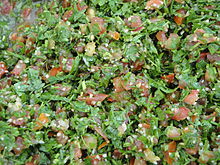| Revision as of 17:28, 10 July 2018 view sourceSer be etre shi (talk | contribs)Extended confirmed users1,328 editsNo edit summary← Previous edit | Revision as of 15:30, 26 July 2018 view source 77.235.148.202 (talk) Fixed typoTags: canned edit summary Mobile edit Mobile web editNext edit → | ||
| Line 4: | Line 4: | ||
| | image = Traditional Tabbouleh.JPG | | image = Traditional Tabbouleh.JPG | ||
| | caption = Tabbouleh | | caption = Tabbouleh | ||
| | country = ] and ] | | country = ] and ] | ||
| | region = ], ], ] | | region = ], ], ] | ||
| | course = ] | | course = ] | ||
Revision as of 15:30, 26 July 2018
 Tabbouleh Tabbouleh | |
| Course | Salad |
|---|---|
| Place of origin | Lebanon and Syria |
| Region or state | Middle East, South Caucasus, Southern Europe |
| Serving temperature | Cold |
| Main ingredients | Parsley, tomato, bulgur |
| Variations | Pomegranate seeds instead of tomato |
Tabbouleh (Template:Lang-ar tabūla; also tabouleh, tabbouli, tabouli, or taboulah) is a Levantine vegetarian salad made of mostly finely chopped parsley with tomatoes, mint, onion, bulgur (cracked wheat), and seasoned with olive oil, lemon juice, salt and pepper. Some variations add garlic or lettuce, or use couscous instead of bulgur.
Tabbouleh is traditionally served as part of a mezze in the Arab world. Its popularity has grown in Western cultures.
Etymology
The Levantine Arabic tabbūle is derived from the Arabic word tābil, meaning "seasoning" or more literally "dip". Use of the word in English first appeared in the 1950s.
History
Edible herbs known as qaḍb formed an essential part of the Arab diet in the Middle Ages. Dishes like tabbouleh attest to their continued popularity in Middle Eastern cuisine today. Originally from the mountains between Lebanon and Syria, tabbouleh has become one of the most popular salads in the Middle East. The wheat variety salamouni cultivated in Syria, Beqaa Valley and Baalbek was considered (in the mid-19th century) as particularly well-suited for making bulgur, a basic ingredient of tabbouleh.
Regional variations
In the Middle East, particularly Syria, Lebanon, Palestine, Israel, Jordan and Iraq, it is usually served as part of a meze. The Lebanese use more parsley than bulgur wheat in their dish. A Turkish variation of the dish is known as kısır, while a similar Armenian dish is known as eetch. In Cyprus, where the dish was introduced by the Syrians, it is known as tambouli. In the Dominican Republic, a local version introduced by Syrian and Lebanese immigrants is called Tipile.
Like hummus, baba ghanoush, pita, and other elements of Arab cuisine, tabbouleh has become a popular American food.
See also
- Syrian cuisine
- Lebanese cuisine
- Palestinian cuisine
- Jordanian cuisine
- Iraqi cuisine
- List of salads
- List of vegetable dishes
- Fattoush
- Couscous
References
- Sami Zubaida, "National, Communal and Global Dimensions in Middle Eastern Food Cultures" in Sami Zubaida and Richard Tapper, A Taste of Thyme: Culinary Cultures of the Middle East, London and New York, 1994 and 2000, ISBN 1-86064-603-4, p. 35, 37; Claudia Roden, A Book of Middle Eastern Food, p. 86; Anissa Helou, Oxford Companion to Food, s.v. Lebanon and Syria; Maan Z. Madina, Arabic-English Dictionary of the Modern Literary Language, 1973, s.v. تبل
- Oxford Companion to Food, s.v. tabbouleh
- ^ Zelinsky, 2001 p. 118.
- ^ Mark Morton (2004). Cupboard Love: A Dictionary of Culinary Curiosities (2nd ed.). Insomniac Press. p. 302. ISBN 978-1-894663-66-3.
- "Tabouli: Lebanese Parsley and Bulgur Salad". Arousing Appetites. Arousing Appetites.
- Wright, 2001, p. xxi.
- Madison Books, ed. (2007). 1,001 Foods to Die For. Andrews McMeel Publishing. p. 172. ISBN 978-0-7407-7043-2.
- ^ Basan, 2007, p. 180-181.
- Nabhan, 2008, pp. 77-78.
- Wright, 2001, p. 251. "In the Arab world, tabbouleh (tabbūla) is a salad usually made as part of the mazza table (p xx) especially in Syria, Lebanon and Palestine."
- https://books.google.ca/books?id=bB2cedC3ruQC&pg=PA56
Bibliography
- Basan, Ghillie (2007). The Middle Eastern Kitchen. Hippocrene Books. ISBN 978-0-7818-1190-3.
- Caplan, Patricia (1997). Food, health, and identity (Illustrated ed.). Routledge. ISBN 978-0-415-15680-6.
- Nabhan, Gary Paul (2008). Where our food comes from: retracing Nikolay Vavilov's quest to end famine (Illustrated ed.). Island Press. ISBN 978-1-59726-399-3.
- Wright, Clifford A. (2001). Mediterranean vegetables: a cook's ABC of vegetables and their preparation in Spain, France, Italy, Greece, Turkey, the Middle East, and north Africa with more than 200 authentic recipes for the home cook (Illustrated ed.). Harvard Common Press. ISBN 978-1-55832-196-0.
- Zelinsky, Wilbur (2001). The enigma of ethnicity: another American dilemma (Illustrated ed.). University of Iowa Press. ISBN 978-0-87745-750-3.
External links
![]() Media related to Cuisine of Syria at Wikimedia Commons
Media related to Cuisine of Syria at Wikimedia Commons
![]() Media related to Cuisine of Lebanon at Wikimedia Commons
Media related to Cuisine of Lebanon at Wikimedia Commons